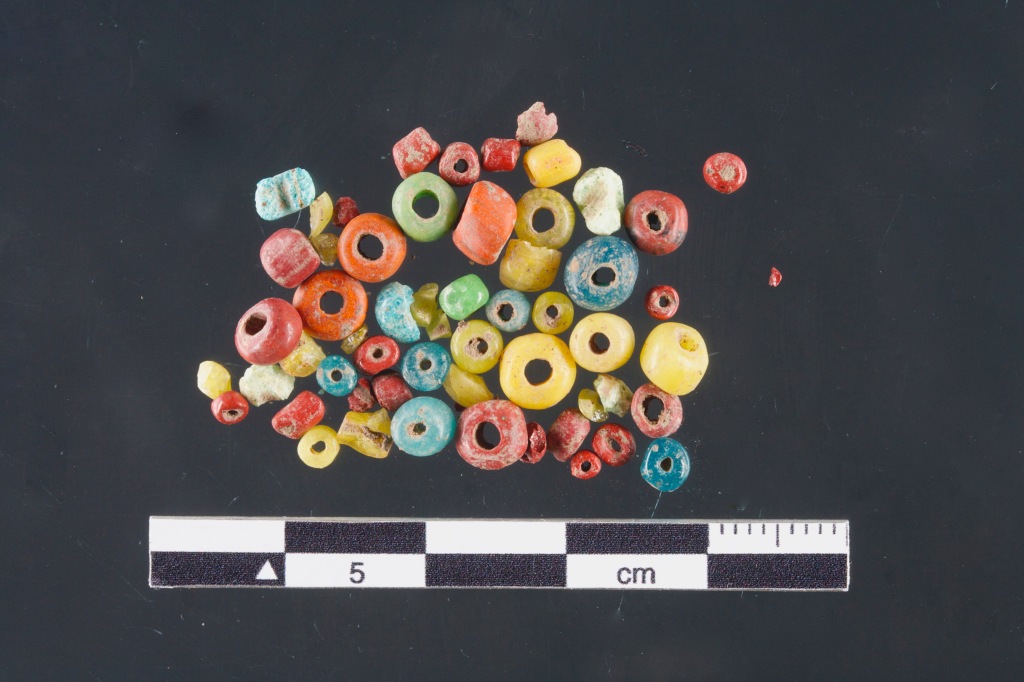It’s been while since I’ve posted on this blog, but figured I’d revive it briefly to share some recent news.
In May, my colleagues and I published an article in Science Advances estimating the population of Angkor over time. My co-author, Sarah Klassen, and I wrote about how we did this for The Conversation and I also posted a video in Khmer explaining our work.
A second co-authored article was just published in Asian Perspectives** that examines in more detail the stone and glass beads from the site of Angkor Borei in southern Cambodia. I’m going to use this blog post to talk about this research in a bit more detail.
Long time readers will know that studying the stone and glass beads of “Iron Age” or “Early Historic” (approx. 500 BCE – 500 CE) Southeast Asia is my first love and the focus of my dissertation research. This publication represents a long overdue report on a bead collection I studied for my dissertation, updated with some new information and research.
Much of the paper details how the stone and glass beads have strong ties to South Asia and represent how Angkor Borei was connected to these international trade networks. However, the part I personally find more interesting is the way beads are being exchanged within Southeast Asia.
Angkor Borei was believed to have been an inland capital of the civilization the Chinese called Funan, a precursor to the later Angkor kingdom. Much of what we know about Angkor Borei comes from the work of the Lower Mekong Archaeological Project led by Dr. Miriam Stark.
In an earlier publication** I detailed two different exchange networks in mainland Southeast Asia, based on the different types of glass and stone beads that were circulated.


At Angkor Borei, we see many carnelian and agate beads that I call “Type 2” – generally beads made in simpler shapes and with lower quality stone or production methods. To me, many of these beads seem like they are being mass produced and contrast with the “Type 1” beads. Type 1 beads are made in more complex shapes (like faceted bicones) and sometimes nicer quality stone. They seem to have taken more time and skill and are not as common.
Angkor Borei also has a lot of high alumina mineral soda glass beads, like those pictured above. This is a bead type that becomes pretty widespread during the early first millennium CE and seems to be produced in India or Sri Lanka. This is different from another type glass bead made from potash glass that we tend to see at earlier and/or more coastal sites.
In this new publication, we mention that we think this particular network of Type 2 agate/carnelian beads and high-alumina mineral soda glass beads represents longstanding connections between sites in the Mekong Delta, like Angkor Borei, and sites further inland that have similar bead assemblages. In this publication we call this network the Mekong Interaction Sphere.

In addition to beads, Shawn Fehrenbach and Miriam Stark have identified some similarities in earthenware ceramic production that also links these regions. The image below is from their recent publication. The orange slipped wares seems like a more localized tradition. Fine buffwares are seen are shared in the Meking Interaction Sphere as well as other coastal sites, and reduced wares also unite sites in the Mekong Interaction Sphere.

This great article by Eileen Lustig, Damian Evans, and Ngaire Richards also shows longstanding connections between the Mekong Delta regions and these regions farther inland during the mid-late first millennium CE. You can see how inscriptions (and by proxy the presence of elite rulers/power) are concentrated in the Mekong Delta and then start moving inland over time. By the 11th century CE, the majority of inscriptions are around Siem Reap/Angkor (unsurprising), but the Mekong Delta remains relevant even after Funan’s power seemingly declined.

Seeing control of trade in the archaeological record is difficult without written documents. However, given Angkor Borei’s location close to the coast and its power as an early urban center, I strongly suspect that many of the stone and glass beads in Cambodia and other parts of mainland Southeast Asia originated from this location. I hypothesize that these beads are one of the material indicators demonstrating connections between people in the Mekong Delta and those farther inland. The distribution of beads is an early marker of this Mekong Interaction Sphere; connectivity that continued for hundreds of years until the Angkor period. Further work will be needed to determine if it extends back in time even farther.
**If you don’t have access to this article through your institution or another venue and would like to read it please email me at alisonincambodia at gmail dot com.


 BarCamp Phnom Penh
BarCamp Phnom Penh